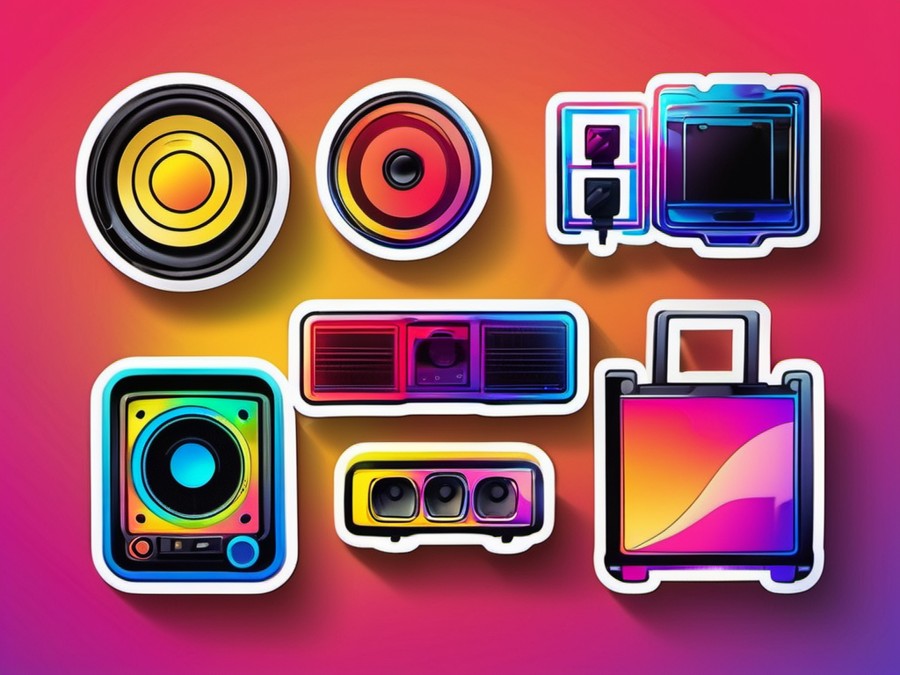· Charlotte Will · Wireless Audio Receivers & Adapters · 8 min read
What is the Difference Between Wireless Audio Receivers and Transmitters?
Dive into the world of wireless audio and learn how wireless receivers and transmitters differ, their key features, real-world applications, and top tips for optimizing your setup. Perfect your home theater or multi-room audio experience with this comprehensive guide.

Ever wondered what the difference is between a wireless audio receiver and a wireless audio transmitter? If you’re setting up a home theater, trying to improve your home office setup, or just want better audio quality in general, understanding these devices can make all the difference. Let’s dive into the world of wireless audio and unravel the mysteries behind these two essential components.
Understanding the Basics of Wireless Audio Receivers
What Does a Wireless Audio Receiver Do?
A wireless audio receiver is essentially the bridge between your audio source and your speakers. It receives the audio signal wirelessly from a transmitter (or directly from a source like your smartphone) and then sends that signal to your speakers. Think of it as the middleman in your audio setup, ensuring that you get crisp, clear sound without the hassle of tangled wires.
Common Features of Wireless Audio Receivers
- Connectivity Options: These days, wireless audio receivers come with a variety of connectivity options, including Bluetooth, Wi-Fi, and sometimes even wireless protocols like RF (Radio Frequency).
- Range and Reliability: A good wireless audio receiver should offer a decent range and reliable connectivity, ensuring that your audio doesn’t cut out unexpectedly.
- Multi-Room Capabilities: Many modern receivers support multi-room audio setups, allowing you to play music in different rooms simultaneously.
Setting Up a Wireless Audio Receiver
Setting up a wireless audio receiver is generally straightforward:
- Connect the Receiver: Plug your receiver into a power source and connect it to your speakers using the appropriate cables (usually RCA or 3.5mm).
- Pair the Devices: If you’re using Bluetooth, pair your receiver with your audio source (e.g., smartphone). For Wi-Fi connections, you might need to use a dedicated app provided by the manufacturer.
- Enjoy: Once everything is connected, you’re ready to enjoy high-quality wireless audio.
For more details on setting up a wireless audio receiver, check out this guide.
Wireless Audio Transmitters: An Overview
The Purpose of a Wireless Audio Transmitter
A wireless audio transmitter’s primary job is to send the audio signal from your source (like a TV, CD player, or computer) to your receiver. It takes the audio output and transmits it wirelessly, eliminating the need for bulky cables.
Key Features to Look For in a Wireless Audio Transmitter
- Compatibility: Make sure your transmitter is compatible with your audio source. This often means checking for the right input ports (e.g., RCA, optical).
- Transmission Range: The transmission range can vary greatly depending on the model and wireless technology used. Ensure it meets your needs, especially if you’re planning a multi-room setup.
- Latency: Low latency is crucial for tasks like watching movies or playing video games. You don’t want the audio to lag behind the video.
How to Use a Wireless Audio Transmitter
Using a wireless audio transmitter is just as simple:
- Connect the Transmitter: Plug your transmitter into a power source and connect it to your audio source using the appropriate cables.
- Pair with Receiver: Ensure that your transmitter is paired or connected to your wireless audio receiver.
- Start Listening: Once everything is set up, you can start enjoying your wireless audio experience.
For more information on using a wireless audio transmitter, read this article.
Comparing Wireless Audio Receivers and Transmitters
Key Differences in Functionality
While both devices play crucial roles in your audio setup, their functions are distinct:
- Receiver: Receives the signal and sends it to your speakers.
- Transmitter: Sends the audio signal from your source to the receiver.
Comparing Range and Reliability
Range and reliability can vary based on the wireless technology used. Bluetooth, for instance, typically has a shorter range than Wi-Fi but is often more reliable in certain environments. Factors like interference and obstacles can affect both range and reliability.
Compatibility and Ease of Use
Both receivers and transmitters need to be compatible with your audio devices. Check for the right input/output ports and ensure that your wireless technology (Bluetooth, Wi-Fi) is supported. Most modern devices are user-friendly and come with clear setup instructions.
Choosing Between Wireless Audio Receivers and Transmitters
When to Opt for a Wireless Audio Receiver
A wireless audio receiver is usually the focal point of your setup. You might need one if:
- You want to stream audio from multiple sources: Receivers can often handle inputs from various devices.
- You’re setting up a multi-room audio system: Many receivers support playing music in different rooms simultaneously.
- You need a reliable way to connect your speakers: A receiver can handle this seamlessly.
When a Wireless Audio Transmitter is the Better Choice
You might need a transmitter if:
- Your audio source lacks Bluetooth or Wi-Fi: A transmitter can bridge the gap, sending audio wirelessly to your receiver.
- You want to extend the range of your audio setup: Transmitters can help send the signal further.
- You need to connect multiple audio sources: Some transmitters can handle inputs from several devices.
Combining Both for Optimal Audio Setup
For a top-notch audio experience, you might want to use both:
- Transmitter: Sends the audio signal from your source to the receiver.
- Receiver: Receives the signal and sends it to your speakers.
This setup is particularly beneficial for multi-room audio systems, ensuring you get the best sound quality throughout your home.
Real-World Examples and Use Cases
Wireless Audio in Home Theaters
In a home theater setup, you might use a transmitter to send audio from your TV or Blu-ray player to a receiver connected to your surround sound system. This allows you to enjoy immersive, wireless audio without the clutter of cables.
For more on home theater setups, read this article.
Wireless Audio for Music Enthusiasts
Music lovers can use a wireless audio receiver to stream high-quality music from their smartphones or computers to their speakers. This setup is perfect for those who want the convenience of wireless connectivity without sacrificing sound quality.
Wireless Audio in Offices and Meeting Spaces
In professional settings, wireless audio can be used to enhance presentations or meetings. A transmitter can send the audio from a laptop or projector to a receiver connected to conference room speakers, ensuring everyone can hear clearly.
Tips for Optimizing Wireless Audio Performance
Ensuring Minimal Latency
Latency can be a buzzkill, especially for activities like gaming or watching movies. To minimize latency:
- Use dedicated devices: Some transmitters and receivers are designed to minimize latency.
- Opt for a wired connection as a last resort: While not wireless, this can sometimes provide the lowest latency.
Maximizing Range and Signal Strength
To get the best range and signal strength:
- Position devices strategically: Place your transmitter and receiver in clear line of sight, avoiding obstacles.
- Use wireless boosters: These can help extend the range of your wireless audio setup.
Troubleshooting Common Issues
If you’re experiencing connectivity problems:
- Check for interferences: Other wireless devices can sometimes cause interference.
- Update your firmware: Ensuring your devices have the latest software can sometimes resolve issues.
- Restart your devices: A simple restart can often fix connectivity problems.
The Future of Wireless Audio Technology
Emerging Trends in Wireless Audio
Wireless audio technology is constantly evolving, with new trends like:
- Higher data rates: Allowing for better sound quality.
- Improved range and reliability: Ensuring a more consistent audio experience.
- Integration with smart home systems: Allowing for seamless control of your audio setup.
How to Future-Proof Your Wireless Audio Setup
To ensure your setup stands the test of time:
- Invest in versatile devices: Choose devices that support multiple wireless technologies.
- Opt for expandable systems: Some systems allow you to add more speakers or receivers as needed.
- Stay updated: Keep your devices up to date with the latest software and firmware.
Conclusion
Understanding the difference between wireless audio receivers and transmitters is crucial for setting up a seamless, high-quality audio experience. Whether you’re looking to enhance your home theater, create a multi-room audio system, or simply enjoy better sound quality, these devices play vital roles in achieving your goals.
By choosing the right devices and setting them up correctly, you can enjoy a wireless audio experience that’s both convenient and high-performing. So go ahead, dive into the world of wireless audio, and let the music flow!
FAQs
Can I use a wireless audio receiver as a transmitter?
- While some advanced receivers can act as both, it’s generally best to use a dedicated transmitter for sending the audio signal.
What are the best brands for wireless audio devices?
- Brands like Sonos, Bose, and Logitech are well-regarded for their wireless audio devices.
How do I know if my device is compatible with a wireless audio receiver or transmitter?
- Check the input/output ports on your device and compare them with those required by the receiver or transmitter.
What are the advantages of using Bluetooth versus Wi-Fi for wireless audio?
- Bluetooth is often simpler to set up and can be more reliable in certain environments. Wi-Fi, on the other hand, typically offers better range and higher data rates for better sound quality.
How can I enhance the range of my wireless audio setup?
- By positioning your devices strategically, using wireless boosters, and ensuring a clear line of sight between the transmitter and receiver.




